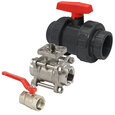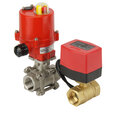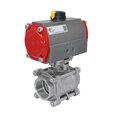A Guide to One-, Two-, and Three-Piece Ball Valves
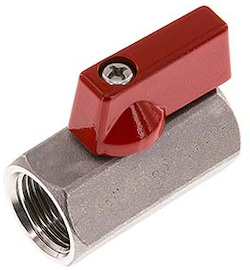
Figure 1: One-piece ball valve
A ball valve is a shut-off valve in piping systems, controlling the flow of liquids or gasses. Understanding the differences between 1, 2, and 3-piece ball valves is essential for selecting the right valve for any application. This article examines the design, performance, and specific applications of these ball valve configurations. This article compares 1, 2, and 3-piece ball valves in detail. Read our ball valve overview article for more details on the design and working of ball valves.
Table of contents
- 1, 2 & 3-piece ball valve
- One-piece ball valves
- Two-piece ball valves
- Three-piece ball valves
- 1, 2 & 3-piece ball valves comparison
- FAQs
View our online selection of ball valves!
1, 2 & 3-piece ball valve
In short, the main difference between 1, 2, and 3-piece ball valves is their body design. A one-piece ball valve has only one body portion. Two-piece ball valves have two body components threaded together or bolted together. Three-piece valves, on the other hand, have three independent components.
One-piece ball valves
Construction
Building a single-piece ball valve is simple as there is only one body part. The valve trim is attached to the seals through end connections made of the same material as the body. Also, the valve's port size will not be the same as the line size, resulting in a reduced bore design. There is very little or rather no leakage with this type of construction. A one-piece ball valve is irreparable, and it can only be replaced. Figure 1 shows a one-piece ball valve.
Advantages
- Due to its simplicity, a one-piece ball valve is relatively cheaper compared to other ball valves.
- It offers little fluid resistance and no friction on the switch.
- The one-piece valve is also light and occupies less space.
- A one-piece ball valve can be easily turned on and off.
- The medium does not quickly erode the piece since the sealing surfaces, and the valve seat is isolated from the medium.
Applications
One-piece ball valves do not have uses in high-demand industries since they are difficult to repair or replace. In applications where a reduced flow is not a concern, one-piece valves can be employed. Foodservice machinery, liquid filling equipment, and motor fluid filling equipment use one-piece ball valves.
Two-piece ball valves
Construction
Two-piece valves have two independent components connecting them, either threaded or a bolt and flange assembly. The pieces have body and end connections. As two separate sections are connected, there is the possibility of leaking. As a result, the two-piece ball valve is unsuitable for high-pressure applications. Because of the connection, the valve can be disassembled for internal component repair.
Advantages
- There is no corrosion on the sealing surfaces since the valve seat, and the sealing is isolated from the medium.
- The structure of the ball valves is also convenient for repair and maintenance.
- It is easy to open or close the ball valve. You only require a 90⁰ rotation on the handwheel.
- The ball valves are compact hence providing good sealing performance.
- The ball size occupies less space, and it is lightweight.
- Fluid resistance is minimal.
Applications
A two-piece ball valve's structure allows it to be used in various applications. The valve can be used with any media because of the ease of maintenance. Food, manufacturing, and automotive industries are just a few of the industries that use two-piece ball valves.
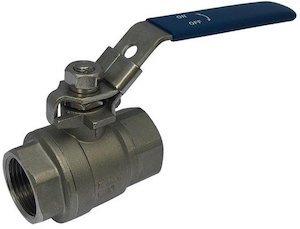
Figure 2: 2-piece ball valve
Three-piece ball valves
Construction
A three-piece ball valve has one main valve body and two pipe connectors. The pipe connectors are welded or threaded to the pipes. Because of the three-piece structure, the valve body and trims can be removed without interfering with the pipe connections. After installing a 3-piece ball valve, the worn-out components like the ball, seat, or stem can be replaced independently and quickly. It is also more expensive than a two-piece ball valve due to its intricate structure. But, the valve can remain in service for its intended lifespan with low long-term maintenance cost.
Advantages
- A three-piece ball saves cost in the long run as it can be cleaned and maintained easily.
- The main body of the valve can be removed without interfering with the connections, avoiding a line shutdown.
- The valve provides for full port and bidirectional shut-off.
- The valve seals can be easily changed by just unbolting the caps.
- The connection in a three-piece ball valve is complete compared to a one or two-piece ball valve.
- These valves can be used in a high-pressure vacuum.
Applications
The structure of a three-piece ball valve makes it suitable for high-pressure applications where the components experience a lot of wear and tear. The valve is ideal for high-cycle industries since the parts can be replaced and serviced without replacing the entire valve. Primarily, manufacturing industries mainly rely on three-piece ball valves to control liquid flow.
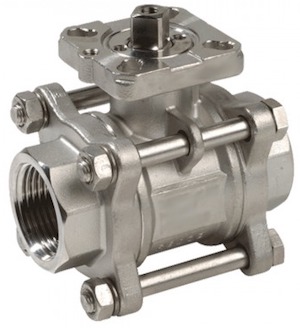
Figure 3: 3-piece ball valve made of stainless steel
1, 2 & 3-piece ball valves comparison
Cost
- Acquiring a one-piece ball valve is the cheaper option.
- Two-piece ball valves are affordable to purchase and replace compared to three-piece ball valves.
- Three-piece ball valves have a high one-time cost, but in the long run, they are cost-effective.
Port availability
- One-piece ball valve does not have the same port size as the line.
- Two-piece and three-piece ball valves are available in full port configurations.
Repair and service
- You cannot repair one-piece ball valves.
- Two-piece ball valves allow for limited repair.
- It is expensive to acquire three-piece ball valves
Applications
- One- and two-piece ball valves have typical food, liquid filling, and automotive industry applications.
- Three-piece ball valves have high-pressure applications in manufacturing industries.
Learn more about selecting the right ball valve for your application in our ball valve selection guide.




